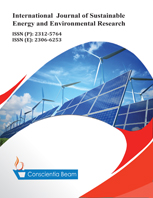Weather influence on the performance of solar collector
DOI:
https://doi.org/10.18488/13.v12i1.3379Abstract
A laboratory-scale evacuated tube solar collector (ETSCs) has been developed and tested for unloading conditions in Lanzhou, China. clear sky and cloudy conditions have been tested. Heat is generally considered instantaneous because it is a function of multiple instantaneous factors, like ambient temperature and solar radiation. The results show a clear sky day with a maximum and average value of ambient temperature, outlet, inlet, and solar radiation of 12 and -60C, 56 and 310C, 69 and 340C, 931 and 576W/m2, respectively, while a cloudy day was eight and -30C and 861.2 and 449W/m2 respectively. Clear sky day maximum and the average mass flow rate was 0.25 and 0.21 Kg/sec, while the cloudy flow rate was 0.27 and 0.03 Kg/sec, respectively. A clear sky has a heat loss of -0.307 and -0.05kW for a cloudy day. R square were 0.76 and 0.4 for clear sky and cloudy day, respectively. For the heat and radiation correlation relationship, a clear sky has a slope of 0.0029 and 0.0539 for a cloudy day. In other conditions, the solar radiation per unit area increases by 1 W/m2, and the daily heat is collected. Increasing A W/m2, the temperature difference between the average temperature of the hot water storage tank and the average temperature of the environment increases by one °C, and the daily heat collection decreases A W/m2. It concludes that a clear sky has much better efficiency than a cloudy day.

